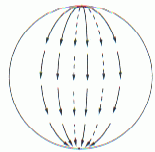
Euler's characteristic, or combing one's hair
Little Winnie was always exaggeratedly pedantic. All his books
had to be perfectly ranged on the bookshelf, the notebooks and
the pens too. Whenever he found his building blocks scattered
around the floor, he hastened to line them up. There was, however,
one problem he could not cope with. He had short, straight and
evenly cut hair and whenever he tried to do it, he was always
left with a point on the top of his head with hairs growing out
of it in every direction. Of course, he realised that the problem
would disappear if he decided to comb all his hair backwards,
but he simply did not want to dress his hair this way. The problem
disturbed him so much, that he began to think about it with his
head between his paws.
"I have an uncle - thought Winnie - who is really hairy,
he is. A thick crop of hair, a big moustache, a beard, cheeks
covered with hair, and those bushy eyebrows! Why, he must have
some problems to comb his hair! And what if his
entire head were covered with hair? If his head were a sphere,
with thick, straight, short, evenly cut hair? Now even combing
his hair backwards wouldn't help much!
With flushed cheeks Winnie started to comb the sphere. He made
a lot of drawings (for he drew the hair on the sphere with a pencil),
but in each case there was a point on the sphere with hairs leaving
it in every direction. At first Winnie was even convinced that
there must be at least two such points. Here is Winnie's first
picture:

Fig. 1
Hairs go out of one on the points in every direction, and, coming
again from every direction, they meet in the other. After thinking
another long time Winnie discovered to his surprise that the sphere
can be combed so as to leave only one singular point (for
that was the name that coined for those points at which the hair
was not arranged in one direction). Here is Winnie's second picture:
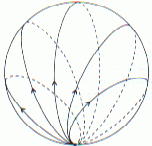
Fig. 2
The hairs are arranged along the lines indicated on the picture.
On a separate sheet of paper Winnie drew what happens near the
singular point:

Fig. 3
The arrangement is such that the hairs are tangent to the lines seen on the picture and the grow in the direction of the arrows. For better comprehension Winnie added colour to four hairs.
Well, well - he thought - I managed to replace two singular points by one, but the one seems to be twice as complicated as the two!
Having forgotten about his original problem, Winnie continued
to play with his imagination. Can the torus be combed? Why, yes,
and without any singular points at all! He found the solution
without any difficulty and presented it on a new drawing:
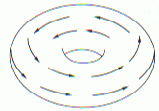
Fig. 4
Unfortunately, he was not able to comb the torus with two holes
without producing singular points:
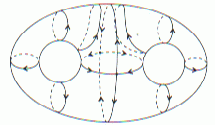
Fig. 5
As before, Winnie made a new picture to show in detail the singular
points on the torus with two holes:

Fig. 6
Here we see again two singular points, just as we have seen before
on the sphere, but now they are of a "different type".
Every now and then Winnie's head was invaded by new questions.
How can distinction be made between different "types"
of singular points? What does it mean that one singular point
is "more complex" than another? What is the link between
the number of holes in a torus, the number of singular points,
and their complexity? All these problems seemed to be very hard,
but Winnie was certain that there is some link, or more
precisely, that there is a link that can be expressed by some
simple formula. To find it I must first express the complexity
of a singular point in numbers - he thought. Another long time
of thinking was sufficient to conclude that the best idea would
be to express it by the index of a singular point,
which he defined in the following way.
To start with, let's draw a very small circle with the singular
point in the centre. Some hairs must lie on its circumference
(they are coloured on the picture below).
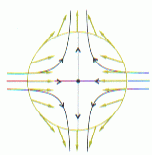
Fig. 7
If we move along the circumference in the anticlockwise direction,
the hairs growing out of the circumference turn and thus change
their direction. While we make the whole circumference to return
to our starting point (always going anticlockwise), the hairs
lying on the circumference make several full revolutions. Winnie
defined the index of a singular point as the number of full revolutions
made by these hairs, and this number is to be taken with a plus
sign +, if the hairs turn anticlockwise, and with a minus -, if
they turn clockwise. All this is quite complicated, so let's look
at some examples to see what it's all about. Every singular point
in Fig. 1 has index 1, the singular point in Fig. 3 has index
2 and each singular point in Fig. 6 has index -1.
Next, Winnie verified empirically that the sum of the indexes
of singular points does not depend on the way the hair is combed!
Thus, for instance, each of the two singular points in Fig. 1
having index 1, their sum is 2, while in Fig. 2 there is one singular
point with index 2. In Fig. 5 there are two singular points, each
with index -1, but there is a way of combing the hair in such
a way that only one singular point appears and its index is -2
(how can this be achieved?). Winnie verified many other examples
and he noticed that in each case the sum of indexes of singular
points is the same independently of the way the hair has been
combed.
Several years have passed...
I wonder, what can the sum of the indexes of singular points be - thought Win while reading this issue of Delta. In the journal he found Euler's formula and to his surprise discovered that
the sum of the indexes of all the singular points on a torus with n holes is constant, does not depend on the combing, and is equal to Euler's characteristic of this torus.
A sphere, of course, is a torus with 0 holes, or - speaking in
human language - without holes.
Can you comb the hair on torus with n holes?
Can you do it to get only one singular point? If you managed to
do the hair on the torus (with n holes), see what is the
sum of the indexes of the singular points and verify that it is
indeed equal to Euler's characteristic of the torus with n
holes.
Even if Win discovered the formula, he was not able to prove it.
Somewhat later he learned that this was the so-called Hopf-Poincaré
formula. Obviously, its precise mathematical formulation requires
much more developed mathematical notions and tools, but this is
another story. Therefore, hoping to reach a deeper understanding
of Hopf-Poincaré's theorem, Winifred took on studies at the mathematics
department of the local university, where he learned that Hopf
generalised his formula to multidimensional surfaces. Are you
interested in the formulation of this generalisation? Follow Winifred...
Piotr Hajlasz